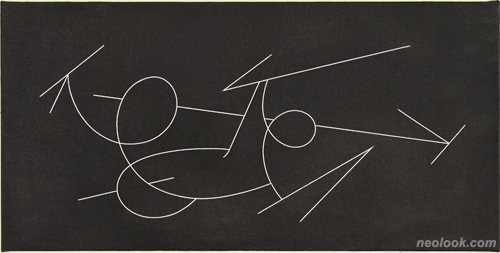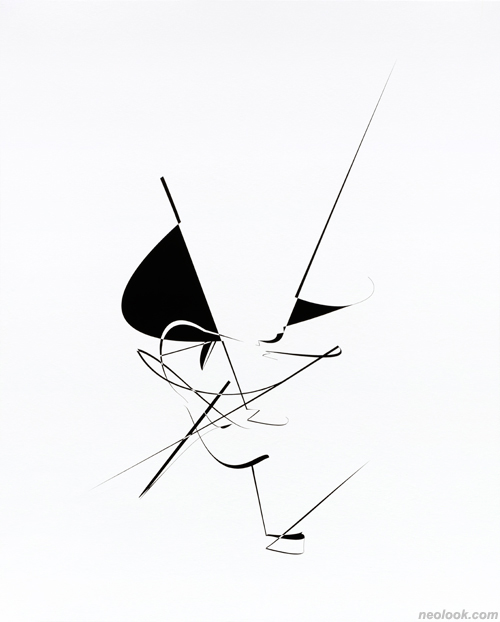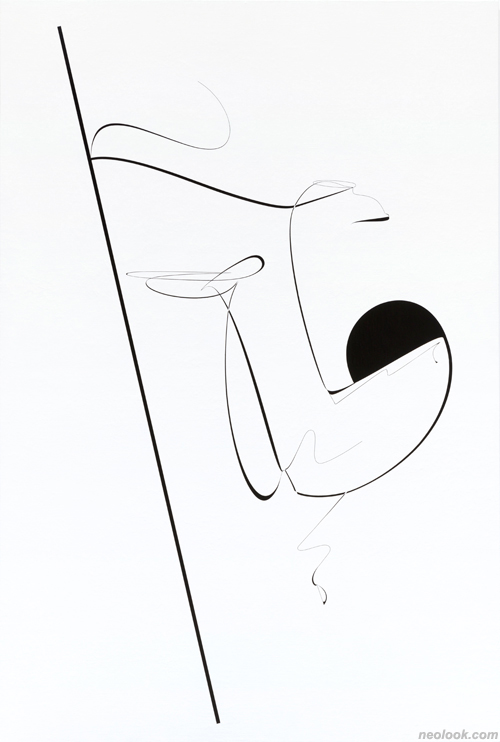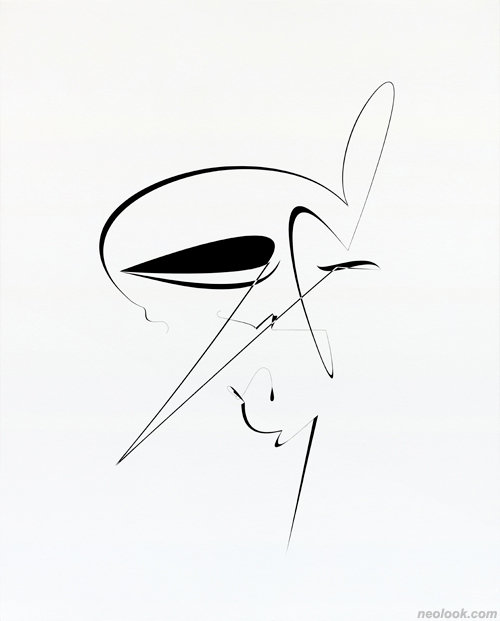- ● homepage
- ● archives
- ● restoration
- ● books
- ● big banners
- ● post board
- ■ neo's search
- ■ about us
- ■ 게재방법 안내
- 개인정보처리방침

- [email protected]
- Tel. 02_335_7922
- Fax. 02_335_7929
- 10:00am~04:30pm
- 월요일~금요일
- 3/3(월) 대체공휴일

The Line
경현수展 / KYUNGHYOUNSOO / 慶賢秀 / painting 2018_1017 ▶ 2018_1110 / 일,공휴일 휴관
● 위 이미지를 클릭하면 네오룩 아카이브 Vol.20170512f | 경현수展으로 갑니다.
초대일시 / 2018_1017_수요일_06:00pm
관람시간 / 11:00am~06:00pm / 일,공휴일 휴관
이유진갤러리 LEE EUGEAN GALLERY 서울 강남구 압구정로77길 17(청담동 116-7번지) Tel. +82.(0)2.542.4964 www.leeeugeangallery.com
흔적 또는 생채기의 향연 ● "프로이트는 아주 직설적으로 이렇게 말했다. 차이 없이는 파열이 없고 차이 없이는 흔적은 없다고." (자크 데리다) ● 경현수는 가시적 세계에 큰 애정을 가지고 있지 않다. 그의 주된 관심은 오히려 세계를 기호로 압축한 상태라고 한다. 자신은 사회적인 것에 관심을 두고 작업을 전개하지 않기에 순수한 기하학적 이미지로 구성된 작업을 전개한다고 설명한다. 그럼에도 그가 목격하는 순수 세계의 바탕에는 모더니즘 이후 전지구적 삶의 토대를 형성하고 있는 어떤 조건들을 엿볼 수 있을 것 같다. 모더니즘이 도시를 중심으로 세워진 정치자본주의의 결과라면, 포스트모더니즘은 이 도시를 하나의 기호와 이미지로 사회화 하는 상태라는 견해를 곰곰이 생각해볼만하다. 그렇다고 경현수가 사회적 의미를 작업에 투영시켰다는 건 아니다. 그럼에도 추상회화는 현실의 문제에서 촉발되었고, 재현과 서사의 거부가 곧 아방가르드 정신을 드러냈다는 건 부정하기 어렵다. 또한 최근 십여 년 사이에 세계적으로 추상성이 다시 미술계의 주목을 받는 데에는 동시대가 처한 어떤 공통적 상황과 무관하지 않을 것이다. 그는 컴퓨터 프로그램 툴을 이용하여 가상공간 안에서 특정한 이미지를 산출한다.

- 경현수_The line_1804_캔버스에 아크릴채색_30×60cm_2018
이 결과물은 점·선·면으로 이루어진 설명하기 어려운 형태를 가진 시각적인 것(optical)으로 부를 수 있다. 이어서 감각을 만족시킬 때까지 반복적으로 겹치고 부수고 다시 쌓으면서 각각의 형태들은 자신만의 리듬을 찾는다. 이제부터 본격적인 작업은 시작된다. 특히 이번 전시에서 각 형태/개체는 하나의 선으로 마치 벌새가 리드미컬하게 공간을 이동하는 궤적으로 나타난다. 각각의 선들은 고유한 속도로 이동하는데 움직이는 거리와 속도가 다른 복수의 선들이 서로 관계를 형성하면서 자연스레 특유의 운율이 발생한다. 즉흥적인 드로잉처럼 보이지만 형태를 찾아가는 과정은 상당히 분석적인 편이다. 작업의 근간을 이루는 색채와 형태는 제한된 평면 공간 속에서 매 작업마다 넘치지도 부족하지도 않는 역동적 균형감을 제시하고 있는 점만 보아도 작가가 얼마나 감정을 통제하고 있는지를 엿볼 수 있다. 이처럼 경현수는 기하학적인 형태들을 채집하고 이 형태들을 마치 언어의 음소처럼 이용한다. 이렇게 만들어진 조형적 어휘들은 매우 인위적인 공정으로 만들어졌지만 결과적으로는 유기적인 리듬과 움직임을 보여준다.

- 경현수_The line_1802_캔버스에 아크릴채색_162.2×130.3cm_2018
경현수는 평면과 입체 작업을 오가면서 기하학적 추상을 지속적으로 실험한다. 그의 작업은 구상적 정보가 희미하기에 의미전달을 위한 기호로서의 이미지와는 거리가 있다. 따라서 비재현성과 탈서사성으로 대표되는 20세기 초 기하학적 추상 계열의 미학적 태도를 적잖히 연상시킨다. 추상미술의 역사는 재현과 서사에서 벗어나는 과정으로 결과적으로는 미술의 순수성이 무엇인지를 찾아가는 여정으로 볼 수 있다. 추상미술은 새로운 시각적 모험으로 그 자체로만 본다면 르네상스에 비견할 만큼의 도전정신을 필요로 했다. 추상미술은 고전미술의 영향으로부터 완전히 자유로운 어떤 세계를 추구하였다. 20세기 1차 세계대전의 발발은 추상미술이 탄생하는 결정적 계기가 되었다. 물질중심주의 문명의 한계는 곧 금욕적일만큼 강한 정신의 요구로 나타났고 추상의 두 선구자인 칸딘스키와 몬드리안도 마찬가지였다. 그들이 믿었던 세계는 인간의 욕망으로 파괴되었고 이웃도 일상도 사라지는 처절한 경험은 세계의 외형이 아닌 변형될 수 없는 본질을 탐구할 수밖에 없는 동인이었다.

- 경현수_Instant line_1805_캔버스에 아크릴채색_33.4×19cm_2018
그렇게 기하학적 추상은 세계를 재현하지 않고 그 세계를 움직이는 생명의 동력과 그 바탕을 구축하는 원리를 제시한 아방가르드가 되었다. 그렇다면 미술사적 관점으로 볼 때, 경현수의 회화는 포스트모던 추상으로 부를 수 있을 것 같다. 그 이유는 작업의 주요한 모티브인 '잔해'에 있다. 경현수 작업에 있어서 잔해는 기원도 기억도 갖지 않는 형태들로 오로지 끊임없이 변형되는 조형적 원소를 지시한다. 그러나 그것은 무엇의 흔적이다. 과거는 없고 오로지 현재에 남아있는 흔적 또는 생채기(scratch)와 같다. 그래서 경현수의 작업에서 눈여겨보아야 할 지점은 바로 '차이'에 있다. 어떻게 끊임없이 변화하는지, 그리고 이 변화가 진화나 성장이 아닌 변화 자체에 있다는 점을 우리 스스로 인식하는 것이다.

- 경현수_Instant line_1805_캔버스에 아크릴채색_45.5×27.3cm_2018
동시대 미술이 무엇인지 정의 내릴 수 있다는 말은 어딘지 모르게 어색하게 들린다. 그런 감정이 드는 이유는 누구도 동시대 미술이 무엇인지 확신을 가지고 말할 수 없기 때문일 것이다. 물론 분명히 세계 미술계를 주도하는 어떤 흐름들이 존재하고, 누군가에게 영감을 주는 작가들이 나타나지만 그것이 곧 동시대 미술에 의미를 가져다주지는 않는다. 이는 말 그대로 요즘의 흐름일 뿐, 그것이 동시대 미술을 대표할 수는 없다. 그럼에도 마르셀 뒤샹의 '레디메이드' 개념은 여전히 유효한 작업방식이자 미술의 동시대성을 열어준 가장 결정적 단초를 제공한다. 많은 예술가들이 뒤샹의 이 개념 덕분에 노동과 재현의 속박에서 벗어날 수 있었다. 물론 오래된 이야기이지만, 여전히 유효할 뿐만 아니라 곱씹어보아야 할 이야기이기도 하다. 뒤샹은 제품 설명서의 도안과 같은 레디메이드를 자주 이용하여 드로잉으로 발전시키곤 하였다. 그의 반예술적 태도는 산업화된 시스템을 통하여 인간이 상실한 것과 되찾아야 할 이상적 세계를 건조하게 암호화하였다.

- 경현수_The line_1806_캔버스에 아크릴채색_112.1×145.5cm_2018
경현수 역시 작업의 바탕에는 그리기 방식에 관한 본질적인 물음이 자리 잡고 있다. 물론 수많은 현대작가들이 작업방식에 의문을 품고 물질/비물질을 오가면서 새로운 도구, 질료, 매체를 탐구한다. 그중에서도 경현수는 감정적 표현을 엄격하게 제어한 그래픽 디자인이나 건축 설계 방식을 선호한다. 하지만 위 방식들과의 근본적 차이는 기능성이 전혀 없는 겹치고 쌓고 부수고 그속에서 다시 어떤 조형적 원소를 추출하는 반복적이고 무의미한 놀이의 태도를 갖는 것이다. 이 과정에서 잔해(debris)라는 개념이 등장하는데, 잔해란 이 과정 중에 무의식적으로 만들어진 잉여물이다. 그것은 원본의 기호성에서 상당히 멀리 떨어진 상태로, 철학적으로는 차연(différance)의 상태라 부를 수 있다. 데리다의 철학 개념인 차연은 서구형이상학이 제시하는 이원론적 인식체계의 한계를 극복하기 위하여 말과 글을 해체한다. 말은 신화적인 세계이고 글을 말의 상징이란 낡은 관념 대신 이 둘을 분리한 것이다. 경현수는 레디메이드인 지도의 길을 발췌하여 작업의 동기로 삼는다. 그러나 이 동기는 발췌된 상태로 멈춘 게 아니라 해체의 과정을 거듭하면서 원본과 분리된 하나의 개체로 생성된다. 따라서 잔해란 원본의 부스러기라는 의미가 아닌 그것으로부터 독립된 원소로 보는 게 마땅하다. 허나 사람들은 그의 작업에서 선으로 형성된 조형적 세계를 관찰하기보다 발췌된 기호, 그 중에서도 '도로'를 해체했다는 사실에 보다 집중했다고 한다.

- 경현수_The line_1807_캔버스에 아크릴채색_193.9×130.3cm_2018
작가의 말을 빌리자면, 그 선들을 굳이 지도에서 잘라내지 않아도 되었다고 한다. 자신이 필요한 건 바로 선이었고, 지도에 표시된 도로들을 레디메이드 삼아 작업을 전개하는 게 더욱 중요한 사실이라고 덧붙였다. 그러니까 선이 추출된 원본과 길의 의미가 실제로 작업에 의미를 부여하는 것은 아니다. 데리다에 따르면, "표상으로 사용되는 것은 표상으로 사용될 뿐이기 때문에 표상 대상과는 아무런 연관이 없는 타자이며, 지시구조에 의해 만들어지면서, 자체로부터 분리된다." (『해체』, 89쪽) 어쩌면 경현수는 기호의 집합체인 도시적 삶에서 기호를 의미의 감옥에서 구출하는 작업을 실천하고 있다고 해석할 수도 있겠다. 앞서 언급한 바와 같이 요즈음 유독 추상미술이 자주 목격되는 이유 중 하나도 여기에 있을 것이다. ■ 정현

- 경현수_The line_1808_캔버스에 아크릴채색_90.9×72.7cm_2018
A Feast of Traces or Scratches ● "Freud says so overtly. There is no breach without difference and no difference without trace." (Jacques Derrida) ● Hyounsoo Kyung does not hold a deep affection for the visible world. Rather he says his main interest lies in the state of the world abstracted as signs. As his work is not based on his interest of social issues, he explains that he works on compositions of pure geometric images. Despite this claim, it seems that under the pure world that he observes we can see some conditions that form the basis of a globalized life after Modernism. If Modernism is the result of political capitalism formed around the city, Postmodernism can be regarded as a state of socialization of the city into a sign and an image. That is not to say, however, that Hyounsoo Kyung projected social context into his work. Nevertheless, it is difficult to deny that abstract paintings were catalyzed by the problems of reality, and that the rejection of representation and narrative revealed the avant-garde spirit. In addition, the renewed worldwide attention given to abstraction in the recent decade may have ties to some collective circumstance of contemporary culture. He uses a digital program to generate specific images in a virtual space. The resulting composition is not easily describable and may only be referred to as something optical comprised of points, lines, and planes. As he repeatedly overlaps, deconstructs, and stacks these forms until the senses are satisfied, each shape comes to find its own rhythm. From this point, full-scale work begins. In particular, each form/object in this exhibition appears as a line, as a trajectory of a hummingbird rhythmically moving through a space. Each line travels at a specific speed, and a natural rhythm manifests as a plurality of lines of different distances and velocities form a relationship with one another. It may appear to be an improvisational drawing, but rather the process of finding the form is quite analytical. The color and form, which form the basis of the work, create a dynamic sense of balance that neither overflows nor is lacking in the confines of its planar limits. This alone gives us a glimpse of how much the artist is controlling of his emotions. Hyounsoo Kyung thus collects the geometric forms and uses them as if they are phonemes of a language. They are made through very artificial processes, yet in the end these pieces of formative vocabulary display organic rhythms and movements. ● Hyounsoo Kyung continues to experiment with geometric abstraction while working on both planar and cubic work. Due to its vagueness of figurative information, his work is somewhat far removed from images that communicate meaning through symbolism. Therefore, his work somewhat reminds us of the aesthetic attitude of the geometric abstract line of the early 20th century, characterized by the non-representation and de-narrative. The history of abstract art is a process of breaking free of the norms of representation and narrative, and ultimately, can be seen as a journey to find the essence of purity in art. As a new visual adventure, abstract art required a spirit of challenge comparable to that of the Renaissance. Abstract art pursued a world completely free from the influence of classical art. The outbreak of World War I in the 20th century was a crucial moment for the birth of abstract art. The limits of material civilization led to the call for a strong, almost ascetic, spirit; and Kandinsky and Mondrian, the two pioneers of abstract art, breathed the same Zeitgeist. The world they had placed their faith in had been destroyed by human desires, and the monstrous experience of neighbors and the disappearance of ordinary life were motives for them to explore not the surface but the unmodifiable essence of the world. Thus, geometric abstraction became the avant-garde. It did not replicate the world but instead was suggestive of the underlying principles of its foundations and the motive power of life that sets this world in motion. From an art-history point of view, Hyounsoo Kyung's painting can be said to be Postmodern abstraction. The reason for this lies in the 'debris', the main motif of his work. As a form that does not have origins nor memories, the debris in the work of Hyounsoo Kyung is indicative of formative elements that are constantly in the flux of transformation. Nonetheless, it is a trace of something. It is like a trace or a scratch that has no past but only exists in the present. So, the focal point in Hyounsoo Kyung is the 'difference'. The point is that we ourselves recognize how there occurs constant change, and that the nature of this change is not of evolution or growth but simply change itself. ● It sounds somewhat awkward to hear someone claim that they can define what contemporary art is. This because there is no one that can truly say with confidence what contemporary art is in its entirety. Certainly, there are trends that lead the global art world and there emerge artists who give inspiration to others, but this in itself does not bring meaning to contemporary art. It is literally a current trend; it cannot represent contemporary art. Nevertheless, Marcel Duchamp's concept of the 'ready-made' is still a valid work method and provides one of the most decisive starting points for contemporary art. Thanks to this concept of Duchamp, many artists were able to escape the bondage of labor and representation. It is an old story, to be sure, but it is still a valid one; not only that, it is a story we must ponder over. Duchamp often used ready-mades, which resembled the diagrams in product manuals, to develop them into his own drawings. With an anti-artistic attitude, he encrypted in a dry manner what the humans had lost through the industrialized system and his perception of the ideal world that could be regained. Under the work of Hyounsoo Kyung, too, lies a fundamental question about the method of drawing. Of course, many contemporary artists question the way they work, crossing the boundaries of the material and non-material, and exploring new tools, materials, and media. Among them, Hyounsoo Kyung prefers graphic design or architectural design which strictly regulates emotional expression. However, the fundamental difference from the above methods is the attitude of repetitive and meaningless 'play' of overlapping, stacking, and deconstructing, which are stripped of functionality, and repeatedly extracting some formative elements from the process. During this process, the concept of 'debris' enters, which is a formative surplus unconsciously derived from this process. Far removed from the semiotic state of the original, it can philosophically be called the state of différance. Derrida's concept différance deconstructs words and writing to overcome the limitations of the epistemological dualism in Western metaphysics. Moving away from the old notion that the word is of the mythical world and writing is the symbol of the word, Derrida came to distinguish between the two. Hyounsoo Kyung extracts the roads from the map, which are a ready-made, to use them as a motive for his work. However, this motive does not remain an excerpt, but through the repeated process of dissolution, it is created as an entity separate from the original. Therefore, debris should be regarded not as crumbs of the original, but rather as an independent element. Yet, rather than observing the formative world consisting of lines in his work, people concentrate more on the excerpted signs, particularly on the fact that the artist has deconstructed the 'road'. To quote the artist, he states that he did not have to necessarily derive the lines from a map. He adds that what he needed were lines, and that the more important aspect of this process was that he used roads marked on the map as ready-mades. Therefore, the meaning of the original and the roads extracted for the lines used in his work do not actually provide meaning to the work. According to Derrida, "Because what is used as a representation is only used as a representation, it is the 'other' that has nothing to do with the object of representation, and is created by the structure of indication and separated from itself. (Deconstruction) Perhaps Hyounsoo Kyung may be interpreted to be freeing the signs from their prison of meaning amidst the collective of signs that is urban life. As mentioned earlier, perhaps this is the reason why we witness abstract art so often nowadays. ■ Hyun Jung
Vol.20181017j | 경현수展 / KYUNGHYOUNSOO / 慶賢秀 / painting

